Camp Academia
Camp Academia (Bulgarian: лагер Академия, romanized: lager Akademiya, IPA: [ˈɫaɡɛr ɐkɐˈdɛmijɐ]) is a geographical locality in eastern Livingston Island, South Shetland Islands, Antarctica, named for the Bulgarian Academy of Sciences in appreciation of Academy’s contribution to the Antarctic exploration. The site was first occupied in the 2004/05 austral summer, and has been designated since 2004 as the summer post office Tangra 1091, the southernmost branch of the Bulgarian Posts Plc.
Camp Academia | |
|---|---|
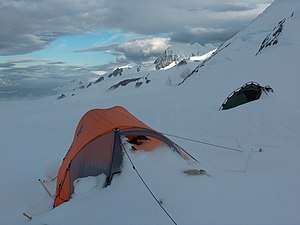 Camp Academia under snow | |
 Camp Academia Location of Camp Academia in Antarctica | |
| Coordinates: 62°38′42″S 60°10′18″W | |
| Country | |
| Location in Antarctica | Livingston Island South Shetland Islands Antarctica |
| Administered by | Bulgarian Academy of Sciences |
| Established | 2004 |
| Type | Seasonal |
| Period | Summer |
| Status | Operational |
 Bulgaria in Antarctica |
| Bulgarian Antarctic Institute |
| National Centre of Polar Research |
| St. Kliment Ohridski Base |
| Lame Dog Hut |
| Livingston Island Museum |
| St. Ivan Rilski Chapel |
| Camp Academia |
| Tangra 2004/05 |
| Bulgarian toponyms in Antarctica |
| Antarctic Place-names Commission |
| Military Geographic Service |
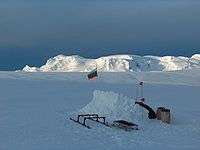
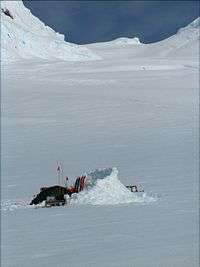
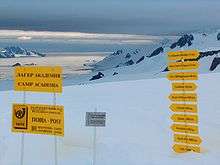
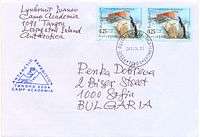
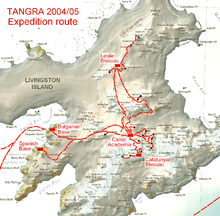
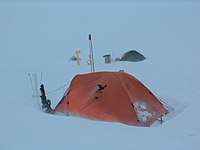
Access and survey routes
Camp Academia is strategically situated in upper Huron Glacier, Wörner Gap area, at elevation 541 m in the northwestern foothills of Zograf Peak, central Tangra Mountains. The site is accessible by 11-12.5 km routes from the Bulgarian base St. Kliment Ohridski and the Spanish base Juan Carlos I respectively.
Camp Academia offers convenient overland access to the main range of Tangra Mountains to the south (with survey and climbing routes leading from Camp Academia to Lyaskovets Peak and Mount Friesland via Catalunyan Saddle, and to Levski Peak, Great Needle Peak and Helmet Peak areas via Lozen Saddle); to Bowles Ridge, Vidin Heights, Kaliakra Glacier and Saedinenie Snowfield areas to the north; to Huron Glacier to the east; and to Pliska Ridge, Burdick Ridge, Perunika Glacier and Huntress Glacier to the west.
Tangra 2004/05 Survey
Camp Academia hosted the base camp of the Bulgarian topographic survey Tangra 2004/05 from 3 December 2004 until 2 January 2005. The survey was both shipborne from the ships Vanguardia and Akademik Vavilov, and onshore at Livingston Island and Half Moon Island, and was carried out from 25 November 2004 until 11 January 2005 by the two-member team of Lyubomir Ivanov and Doychin Vasilev who covered either on ski or on foot an overall distance of some 200 km, mostly in harsh weather conditions and challenging unfamiliar terrain in Tangra Mountains, Bowles Ridge, Vidin Heights and the glaciers Huron, Kaliakra and Perunika.
First ascents were made of the peaks of Lyaskovets (1473 m), Ongal (1149 m), Zograf (1011 m), Komini (774 m), Melnik (696 m), Miziya (604 m), and several lesser peaks, as well as the third ascent of the summit Mount Friesland (1700 m). Extensive geodetic and geographic information was gathered, including coordinates and elevation data, actual sea shoreline and ice-free zones configuration, as well as a detailed photographic documentation of previously unexplored and remote areas in the interior of Livingston Island and Greenwich Island.
Based on the survey, some 150 geographical features were mapped for the first time and a new 1:100000 topographic map of the two islands was published in 2005. Data from the topographic survey Tangra 2004/05 was used also in the 2008 Bulgarian map of Livingston, Greenwich, Robert, Snow, and Smith Islands.
Field work carried out from Camp Academia during the Tangra 2004/05 survey has been noted by Discovery Channel, the Natural History Museum, the Royal Collection and the British Antarctic Survey as a timeline event in Antarctic exploration.[1][2][3]
Subsequent occupation
Camp Academia hosted the base camps for the first ascent of Great Needle Peak (1,679.5 m or 5,510 ft) by the Bulgarians Doychin Boyanov, Nikolay Petkov and Aleksander Shopov on 8 January 2015,[4] and the first ascent of St. Boris Peak by Boyanov and Petkov on 22 December 2016.[5]
Tangra 1091 Post Office
The post office Antarctica Tangra 1091 of Bulgarian Posts Plc operated during the entire duration of the expedition Tangra 2004/05 in Antarctica from 25 November 2004 until 11 January 2005, in Camp Academia from 3 December 2004 until 2 January 2005. The office was given the postcode 1091, and was run by Postmaster Lyubomir Ivanov in compliance with standard Bulgarian postal regulations and procedures.
The mailing address of the office was: Camp Academia; 1091 Tangra; Livingston Island; Antarctica. The mail (i.e. its postage stamps) was cancelled by a standard circular Bulgarian handstamping cancellation seal (metal issue) with an inscription “POSTE BULGARE ANTARKTIKA TANGRA 1091” on its periphery and date/hour counter in the centre. Other occasional cachets applied on Tangra 1091 mail often included the triangular cachet of Camp Academia with an inscription “ANTARCTIC EXPEDITION TANGRA 2004 CAMP ACADEMIA” and/or other personal, station and ship postmarks.
A total of 517 outgoing mail consignments (letters and postcards) were shipped, 364 of them via Sofia, 150 via Punta Arenas, and 3 via the St. Kliment Ohridski post office. These were distributed geographically between 30 country destinations as follows: Bulgaria – 146, Germany – 144, Belgium – 54, Chile – 50, Britain – 18, U.S.A. – 15, Spain – 13, New Zealand – 11, France – 9, Argentina – 7, Australia – 7, Austria – 7, Switzerland – 7, Falkland Islands – 5, Antarctica (Livingston Island) – 3, Afghanistan – 2, Czech Republic – 2, Italy – 2, Japan – 2, Portugal – 2, Uruguay – 2, Denmark – 1, Greece – 1, Indonesia – 1, Iraq – 1, Montserrat – 1, Slovakia – 1, Slovenia – 1, South Africa – 1, Vanuatu – 1.[6]
Location
Camp Academia is situated at 62°38′41.9″S 60°10′18.3″W, which is 3.6 km east of Orpheus Gate, 5.25 km east-southeast of Rezen Saddle, 3.2 km south-southeast of Omurtag Pass, 4 km southwest of Pirdop Gate, 1.68 km west of Lozen Saddle, 7.1 km west of Karnobat Pass, and 2.68 km north-northwest of Catalunyan Saddle.
See also
Maps

- L.L. Ivanov et al. Antarctica: Livingston Island and Greenwich Island, South Shetland Islands (from English Strait to Morton Strait, with illustrations and ice-cover distribution). Scale 1:100000 topographic map. Sofia: Antarctic Place-names Commission of Bulgaria, 2005.
- L.L. Ivanov. Antarctica: Livingston Island and Greenwich, Robert, Snow and Smith Islands. Scale 1:120000 topographic map. Troyan: Manfred Wörner Foundation, 2010. ISBN 978-954-92032-9-5 (First edition 2009. ISBN 978-954-92032-6-4)
- L.L. Ivanov. Antarctica: Livingston Island and Smith Island. Scale 1:100000 topographic map. Manfred Wörner Foundation, 2017. ISBN 978-619-90008-3-0
- Antarctic Digital Database (ADD). Scale 1:250000 topographic map of Antarctica. Scientific Committee on Antarctic Research (SCAR). Since 1993, regularly upgraded and updated.
Notes
- "Pole Expedition List". ThePoles.com. Archived from the original on 8 March 2005. Retrieved 8 March 2005.CS1 maint: unfit url (link)
- Discovering Antarctica Overview. Discovery Channel UK website, 2012
- 14 November 2004: Tangra. Discovering Antarctica Timeline. Discovery Channel UK website, 2012
- N. Petkov. Livingston Island, Falsa Aguja and Sofia Peak. American Alpine Journal: Climbs And Expeditions, 2016. (Complete expedition report by N. Petkov and D. Boyanov)
- D. Boyanov and N. Petkov. The Peaks of Tangra Mountains: Project Report Part Two 2016/17. Sofia, February 2017 (in Bulgarian)
- L. Ivanov. Bulgarian mail services on Livingston Island (1995/96 and 2004/05 seasons). Sofia, March 2005
Sources
- L.L. Ivanov, Livingston Island: Tangra Mountains, Komini Peak, west slope new rock route; Lyaskovets Peak, first ascent; Zograf Peak, first ascent; Vidin Heights, Melnik Peak, Melnik Ridge, first ascent, The American Alpine Journal, 2005, 312-315.
- Antarctica: Livingston Island, Climb Magazine, Issue 14, Kettering, UK, April 2006, 89-91.
- Ivanov, L.L. Bulgaria in Antarctica. South Shetland Islands. Livingston Island and Greenwich, Robert, Snow and Smith Islands. Sofia: Manfred Wörner Foundation, 2009. 16 pp., with a folded map. ISBN 978-954-92032-7-1
- Ivanov, L. and N. Ivanova. Antarctic: Nature, History, Utilization, Geographic Names and Bulgarian Participation. Sofia: Manfred Wörner Foundation, 2014. 368 pp. (in Bulgarian) ISBN 978-619-90008-1-6
- Ivanov, L. General Geography and History of Livingston Island. In: Bulgarian Antarctic Research: A Synthesis. Eds. C. Pimpirev and N. Chipev. Sofia: St. Kliment Ohridski University Press, 2015. pp. 17–28. ISBN 978-954-07-3939-7
External links
- Tangra 2004/05 Survey
- Tangra - Camp Academia
- Tangra 1091 Post Office
- Das südlichste Postamt Bulgariens - Tangra 1091 (in German)
- Antarctic Place-names Commission of Bulgaria
- Spanish Antarctic Base Juan Carlos I (in Spanish)
- Camp Academia. Copernix satellite image
This article includes information from the Antarctic Place-names Commission of Bulgaria which is used with permission.
.svg.png)